This is a Minolta Vectis S-1, one of only two Single Lens Reflex models developed by Minolta for use with the Advanced Photo System (APS) film format. The camera was made in Malaysia starting in 1996 and was a full system camera with a brand new and unique Minolta V bayonet lens mount of which only eight lenses were made. The Vectis S-1 was a well equipped model, including most of the same features found on mid level 35mm SLRs of the same era, including multiple auto focus and auto exposure modes, a pop up flash, a wide range of shutter speeds, a unique glass and mirror viewfinder with full information display, plus a number of shooting modes. The Vectis was not produced for long, but that might have had more to do with the failure of APS film, rather than the camera itself.
Film Type: Advanced Photo System
Lens: 28 – 56mm f/4 – f/5.6 Minolta V Lens coated 7-elements in 7 groups
Lens Mount: Minolta V Bayonet
Focus: 3.3 feet to Infinity, TTL Phase Detection Autofocus with Manual Focus Override
Viewfinder: Fixed Reflex Mirror Viewfinder with Full Information Display
Shutter: Vertically Traveling Electronic Focal Plane Shutter
Speeds: B, 30 – 1/2000 seconds, step less
Exposure Meter: 14 Segment TTL Silicon Photo Cell w/ Full Programmed Auto Exposure + others
Battery: (2x) 3v CR2 Lithium Battery
Flash Mount: Minolta Hot Shoe + In Body Popup Flash w/ Red Eye, Flash Full, Rear Curtain + others, 1/125 flash sync
Other Features: Self-Timer, Multiple Flash and Exposure Modes, Adjustable Aspect Ratios + more
Weight: 488 grams (w/ lens), 372 grams (body only)
Manual: https://mikeeckman.com/media/MinoltaVectisS1Manual.pdf
How these ratings work |
The Minolta Vectis S-1 was an innovative and pioneering camera that was the first APS SLR to hit the market. Using a design not seen on 35mm SLRs that came before it, a unique mirror and lens based viewfinder, and a whole host of modern features that took full advantage of the new technology that APS had to offer, the Vectis S-1 was a very capable and well thought out camera. Although the APS format was not long lived, it had nothing to do with the success of this model. | ||||||
| Images | Handling | Features | Viewfinder | Feel & Beauty | History | Age | |
| 2 | 2 | 2 | 2 | 1 | 1 | 0% | |
| Bonus | none | ||||||
| Final Score | 10.0 | ||||||
History
 The Advanced Photo System format was in development for nearly 10 years, prior to it’s release in April 1996. Although primarily designed by Kodak, close to 50 different companies all took part in the design and implementation of the new format to give it the best chances of success. Of those companies, five of them, Kodak, Fuji, Nikon, Canon, and Minolta all had the greatest stake in it, and would have camera models ready at launch.
The Advanced Photo System format was in development for nearly 10 years, prior to it’s release in April 1996. Although primarily designed by Kodak, close to 50 different companies all took part in the design and implementation of the new format to give it the best chances of success. Of those companies, five of them, Kodak, Fuji, Nikon, Canon, and Minolta all had the greatest stake in it, and would have camera models ready at launch.
In order to coordinate so many different companies to have sufficient time to build, test, and release their respective camera models, film needed to be available to test them with, and in a “which came first, the chicken or the egg” situation, you cant test film without a camera, and how can you make a camera with no film to use in it?
To solve this quandary, Minolta was the first to come to the rescue with a specially modified 35mm SLR. In July 1996, Popular Photography ran the short article below showing photos of these modified Minolta Dynax 500si cameras. Less than 10 were thought to be made and none were sold to the public.
To accommodate the 24mm wide APS film, special 35mm cassettes were produced that had extra large spool ends. The film and spool was then placed inside a standard 35mm outer shell and loaded into the back of the camera as normal.
The camera was modified with a smaller film gate to match APS film’s size, new film rails altered the focal plane to match APS, and the film door was replaced with one that contained a pressure plate and a photo diode that could detect the perforations in APS film for the purpose of stopping the film advance at each new exposure, and also keeping track of exposures. The modified Minolta did not support the auto film loading of APS film, so for each new roll of film, the leader needed to be manually extended onto the take up spool before the door was closed, just like a normal 35mm camera.
Despite Minolta technically making the first APS SLR, one wouldn’t be ready at launch day, and there’s a chance that this was intentional as none of the other companies had one as well and it’s possible an agreement was made by each of the five companies not to stand up one of the others.
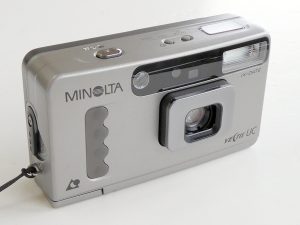
Minolta would have four models, all branded as “Vectis” which would be Minolta’s brand for APS. The four models were the Vectis 20, 25, and 40 with the numbers representing the zoom range of the three models (2.0x, 2.5x, and 4.0x) and the Vectis UC which had a 24mm f/4 prime lens. Of these four models, the Vectis 40 was rebranded by Kodak as the Advantix 5600MRX and the Vectis UC was rebranded by Nikon as the Nuvis Mini and Mini i, suggesting Minolta’s took somewhat of a driver’s seat in the development of these early cameras.
The first reviews for Minolta’s first APS SLR, the Vectis S-1 appeared in April 1996, the exact same month the other 4 models were released. The following review from Popular Photography suggests the camera would be available later that month which suggests the camera was developed parallel to the others. My assumption that the model was intentionally delayed by a couple of weeks was likely done to not up stage, Kodak, Canon, Fuji, or Nikon. Of those four companies, both Canon and Nikon would eventually release APS SLRs, but those would come later.
Unlike the line up of simpler point and shoot models available at launch by Minolta and the other companies who took a conservative design philosophy that didn’t stray too far from existing 35mm point and shoot models, Minolta took a different approach with the Vectis S-1.
While this is my own opinion, it’s almost as if Minolta was excited to produce higher quality cameras and rather than just churn out something that looks like what everyone else was doing, wanted something much more exciting for the Vectis S-1.
At first glance, the Vectis doesn’t look much like an SLR at all. Most featured a black and beige plastic body with a matte pearlescent finish (some were all black), a flat top plate, and an overall size that’s noticeably smaller than the company’s Dynax/Maxxum SLRs of the same era, the only thing suggesting this camera isn’t a point and shoot is the rather large zoom lens mounted to it. The Vectis S-1 featured an all new bayonet V-lens mount and had available a total of five lenses at launch, four zooms, and a 50mm f/3.5 macro.
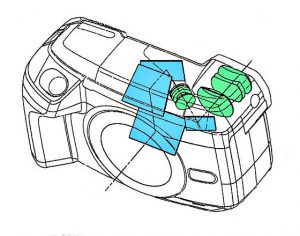
Part of the magic of the un-SLR shape of the camera is that unlike most SLRs, there is no pentaprism for the viewfinder. In it’s place are a clever sequence of mirrors and glass lenses that accomplish the same task to produce a bright and contrary image that is upright and allows the photographer to compose and focus through the lens like any other SLR. Inside the viewfinder was an LCD screen displaying much of the same info as you’d expect on normal 35mm SLR, but this being an APS camera, supported two sets of viewfinder masks to properly display the three C, H, and P shooting modes like other APS cameras.
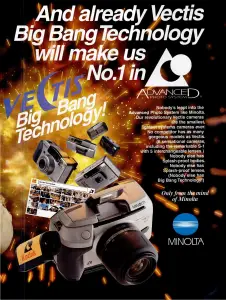
Although the Vectis S-1 was the first APS SLR on the market, by the end of 1996, it had competitors from Canon and Nikon with their EOS IX and Pronea models. Canon took an approach similar to Minolta and went with a completely new design that didn’t look like anything on the market, and Nikon went a bit more conservative. While their lower end Pronea S had a curvy pearlescent white body, the higher end Pronea 600i looked much like their consumer lineup of 35mm SLRs. Both Pronea models shared the Nikon F-mount with 35mm SLRs guaranteeing compatibility for those with existing lenses.
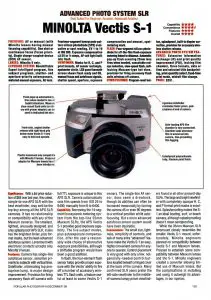
I struggled to find a price for the Vectis S-1 at it’s release as all references to it in ads had a price of $CALL, which was typical for printed ads for newer cameras whose prices fluctuated wildly. It wasn’t until I found the short review of the S-1 in the December 1999 issue of Pop Photo where a price of $291 was mentioned. This price would have likely been much higher three years earlier. In the same issue, Nikon and Canon APS SLRs were all mentioned with much higher prices, suggesting that even in 1996, perhaps the Minolta was still the most affordable option.
While we all know the eventual fate of the APS system, for the first three or so years after it’s release, things seemed to be looking up for it. Early reviews of the Minolta Vectis S-1 were positive across the board with comments praising it’s styling, viewfinder, long list of features, good ergonomics, and excellent performance. Without a doubt, the single most common complaint was that it didn’t share the same lens mount as Minolta’s 35mm Dynax/Maxxum lineup. Unlike Canon and Nikon who both used their respective EF and F mounts shared by their other SLRs, Minolta’s V-mount was not compatible, at least not without an expensive and clunky adapter that added to the size and weight of the camera.
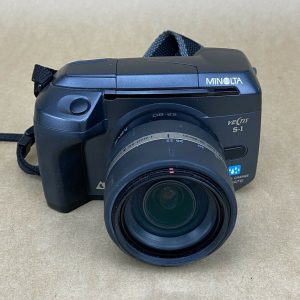
The Vectis S-1 was sold until at least 1999, but shortly after it’s release, a scaled down version called the Vectis S-100 was released. At a quick glance, the S-1 and S-100 look similar, both featuring a similar black and pearlescent beige body, but the S-100 was a greatly scaled down model, which I’ll cover later in this review. Beyond these two models though, Minolta would never release another APS SLR. A combination of slowing sales of both the APS format, and Minolta’s entire camera business likely prevented future expansion of the series. I am uncertain if a second, perhaps the Vectis S-2 was considered, but had it been, it likely would have been even better.
Today, there is very little love for any APS camera, regardless of how good or innovative it was. Top of the line SLRs by Minolta, Nikon, and Canon often go unsold on eBay even with prices as low as $20. In February 2022, I was gifted an entire box of a dozen mint condition APS cameras, by Gene’s Camera Store in South Bend, IN because they didn’t want to bother with the effort required to test and sell them.
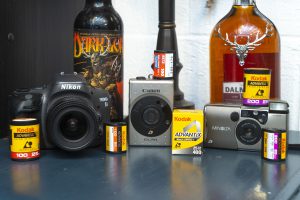
The biggest problem with using APS cameras today is getting and developing APS film. Unlike 35mm film, which is still made today, fresh APS film hasn’t been made in over a decade, and of the expired stocks you can still buy, most of them have aged very poorly and the number of places who can develop the film is very small as well.
Of all the cameras made in the past 200 years, many used a type of film which can no longer buy and most are desirable by collectors, so why models like the Minolta Vectis S-1 aren’t sought after is anyone’s guess. Perhaps the stigma of a failed camera system is still too recent for most collectors. That said though, if there was one APS camera you might want to consider, this is it. It’s a good looking camera with innovative features, and represented the best of what the system could do.
Minolta Vectis S-100
At some point after the release of the Minolta Vectis S-1, a simpler camera called the Vectis S-100 made it’s debut. Very little info exists online and the usual searches for advertising or promotional material return nothing. I am not even sure of when the S-100 came out, but it’s user manual has a copyright date of 1997, so I’ll make the assumption it came out that year.

At a quick glance, the S-1 and S-100 look similar, as both have the same pearlescent beige body, share the same Minolta V bayonet mount, and both have a very similar mirror based viewfinder and popup flash. Beyond that though, the S-100 is a much simpler camera with several cosmetic changes. In no particular order, here is a list of cosmetic and functional differences between the two:
- Redesigned body with smaller hand grip without two tone color and lighter weight (320 grams for S-100 vs 372 grams for S-1)
- Relocated shutter release button and battery compartment (body still use 2x CR2 batteries)
- Smaller rear LCD with less features
- Lack of viewfinder LCD display, only viewfinder indicators are 2 LEDs at the bottom of the eye piece, similar to a point and shoot
- Lack of accessory flash hot shoe
- Left right control wheel, instead of the full dial on the back of the camera
- Programmed AE only operation, no choice for manual or even shutter or aperture priority AE (S-1 supports full PSAM modes)
- Simpler 2-segment TTL Metering (14-segment honeycomb metering in S-1)
- Lack of mid-roll changing, you can only load in new cassette if it’s never been used before
- Shutter top speed and flash sync are reduced to 1/1000 and 1/90 down from 1/2000 and 1/125, also no Bulb mode for long exposures
For the experienced photographer, the list of changes and omissions from the S-1 likely would have been a deal breaker, but considering neither the S-1 nor the S-100 were aimed at the experienced pro, the differences in the S-100 likely didn’t affect anyone who would have considered buying an APS SLR.
I was unable to find any pricing information for the S-100, but in order for Minolta to have sold these two models side by side, I would guess that there had to have been a pretty significant price difference between the two.
My Thoughts
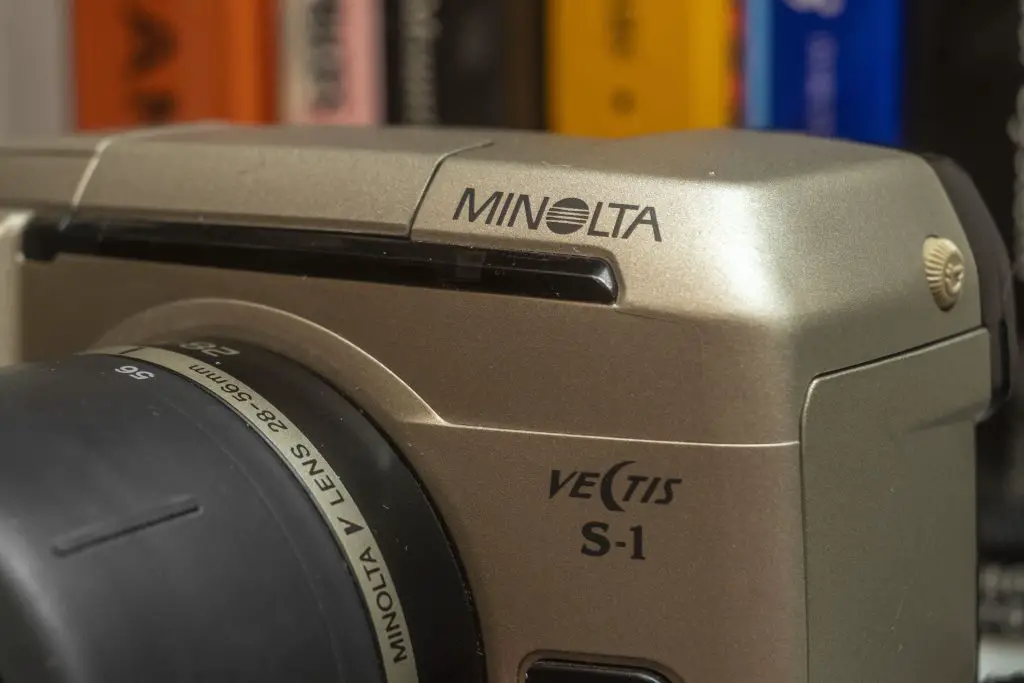
I so wanted to skip APS film….I really did. It’s not that I have anything against extinct film formats. With many reviews of cameras that used 828, 620, 116, 126 Instamatic, Karat/Rapid film and others on this site, a lack of available fresh film is my deterrent.
My experience with APS is limited at best. I was old enough to remember its release in the late 90s, but never having owned any of the cameras, the multiple aspect ratio feature seemed gimmicky and looking back now as a collector, nearly all APS cameras were of the point and shoot variety. I knew there were a couple SLRs, as I actually shot a Nikon Pronea 6i once but the results from that one roll were so terrible, it soured me towards the entire system.
That was until my friend Jon Gilchrist of the Packard-Ideal Shutter Company, who also works at Gene’s Camera in South Bend, IN said he had a box of APS cameras and asked if I wanted it. Knowing what I would likely be in store for with that box, but also acknowledging that my sickness for cameras is very strong, I said sure. A couple of days later, a box full of Kodak, Canon, and Minolta APS point and shoots arrived.
But buried under the massive pile of injection molded plastic was an interesting camera I had never seen before. I have to imagine my “WTF is this” reaction to the Vectis S-1 is not an uncommon coincidence as the camera has an SLR like lens on a non-SLR like body. Think of an Olympus Pen F, but brown plastic instead of metal, soft curved edges instead of angled corners, fatter, with an LCD screen…okay, so it’s not much like the Olympus Pen F other than not looking like a typical SLR.
The Vectis S-1 is neither big nor heavy. Without a lens the body of the camera is only 372 grams. Mount the mostly plastic zoom lens to it, and the weight only increases to 488 grams. Despite being made almost entirely of plastic, the body has sense of quality to it. Holding it firmly in my hands, any attempts to twist or squeeze the body doesn’t produce any creaks or groans. I wonder if the lack of a large hinged door like you’d see on a 35mm camera had some affect on body rigidity.
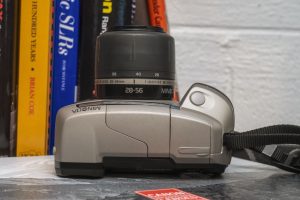
The top plate, like the rest of the camera is very un-SLR like. In fact, from up top, all you’ll see is the shutter release button and narrow gaps for the pop up flash. To the right of the flash and behind the shutter release is a removable plate that when slid towards the back of the camera, reveals a flash hot shoe. The hot shoe is a Minolta style shoe like they used on contemporary 35mm SLRs from the 90s and wont work with flashes for other SLRs. The inclusion of an optional hot shoe is a nice touch, although something I doubt many original owners of these cameras used.
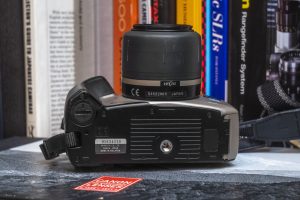
The base of the camera has the round opening for the (2x) 3v CR2 battery compartment and a centrally located 1/4″ tripod socket. The inclusion of a metal tripod socket is a nice upgrade to the cheaper Vectis S-100 which has an offset plastic one that feels like an afterthought.
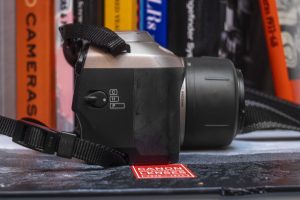
On the camera’s left side is a small diopter adjustment knob for the viewfinder and on the right a three position switch for selecting between Classic (C), HDTV (H) and Panoramic (P) images. All APS cameras, whether or not they support multiple aspect ratios, always shoot in H mode, using a mask on the sides for C mode and at the top and bottom for P mode. The entire image is exposed onto the film with a recording for the photofinisher telling them which type of print is needed for that particular exposure. It is a clever way to implement over aspect ratios compared to 35mm panoramic cameras that just used a mask to physically block off part of the image.

The back of the camera is where nearly all of the camera’s controls are. A row of buttons beneath the LCD are used for the camera’s most common controls, with a small hinged door covering a second row of six more buttons for less common features.

A round control dial is used in conjunction with some of the mode settings, like for manually selecting shutter speeds or f/stops in one of the camera’s manual exposure modes. Lastly, in the upper right corner is a large “P” button which appears on many other Minolta SLRs which acts as a Program Reset button for automatically resetting most of the camera’s custom controls back to default. A collar around the P button selects between one of the camera’s built in scene modes, or for the Aperture Priority, Shutter Priority or Manual Exposure modes.

The LCD predictably shows most of the same types of things you’d expect from a late 1990s SLR including exposure mode, selected shutter speed and f/stop, battery status, exposures remaining, flash mode, and several other modes.

Like all APS cameras, film loads into a dedicated chamber without giving you access to the entire film compartment. Loading a new roll of film is really easy. With the camera on, press the blue eject button to open the film chamber on the left side, drop in a new or partially exposed cassette, and close the door. The camera will do the rest, preparing the roll of film for a new exposure. While I’ll never agree that loading 35mm is difficult, this is one nice upgrade to APS that had the format been more successful, would have been it’s best feature. Like all other APS cameras, once film is in the camera, you cannot eject the film cassette without first rewinding the film.

The Vectis uses a brand new Minolta V-bayonet mount which although unique to this camera, works exactly like any other SLR bayonet you’ve used. A release button at the 3 o’clock position around the mount is used to release the lens, after which a quick twist removes the lens. A series of electronic contacts allow the lens and body to communicate with each other for various exposure and focus modes. Disappointingly, but not surprising, the lens mount on both the camera and lens is made of plastic, which suggested Minolta never had plans for heavy telephotos for the Vectis system.
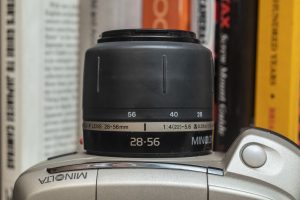
The lens itself is has a large zoom grip for changing the focal length of the lens. According to the manual, some Vectis lenses support a manual focus feature which require you to press a focus mode button located on the side of the lens, which will then allow you to rotate a manual focus ring on the lens. I had access to two different Vectis lenses, neither of which had the ability to manual focus, so I am unsure of how common this feature was.
One of the most unique traits of the Vectis S-1’s design is the lack of an obvious pentaprism hump on top of the camera. This is because the camera uses a series of mirrors and glass lenses instead of a pentaprism, to transmit light entering through the lens to the eye piece. This is how the viewfinder can be located off to the side of the camera.
The first time you look through the eyepiece, you’ll notice that the viewfinder is bright and easy to see through, but it just seems “different”. The design of the viewfinder gives a look similar to looking through a microscope in which the exact position of your eye makes a difference. There is an invisible sweet spot which if your eye is too far away from, or to the side of this spot, you won’t be able to see the entire image. This isn’t difficult to do, but for users like myself who wear prescription glasses, it takes a bit more effort than you’re probably used to using an SLR with a pentaprism.
Once you have your eye in the right position, you see a bright rectangle viewfinder that normally shows the aspect ratio of APS film’s HDTV setting. Using the aspect ratio switch on the side of the camera, baffles above and below the image can be used to change to a 3:2 cropped ratio or a 3:1 panoramic ratio. In the center of the image are focus zone brackets. Unlike more advanced SLRs, these brackets do not light up, they are just there to help you frame what’s being focused.
Beneath the main image is a backlit LCD display panel which shows many of the same things you’d expect to see from contemporary 35mm SLRs such as exposure information, flash status, focus confirmation, and exposures remaining.
The Minolta Vectis S-1 is equal parts SLR and point and shoot camera. It’s simple and easy to use operation would have made it a great step up camera from a simple point and shoot, while it’s more advanced features and availability for interchangeable lenses would have given SLR fans a reason to get excited about APS film.
But despite all of the camera’s cool features, does a “point and shoot APS SLR” make any sense when shooting? Keep reading…
My Results
The Minolta Vectis S-1 wasn’t the first APS camera that has come my way, but it was the first I was interested in shooting, so when it came time to take it out, I opened my drawer full of random rolls of film that I had accumulated over the years.
Knowing that APS film is all color C41 stock and has a reputation for aging poorly, I decided the best chance I would have for getting good exposures was to shoot the slowest film I had, which was Kodak Gold 100. I shot two rolls of film in the fall of 2021 and since I lacked the ability to develop APS film myself, I sent them both to Dwayne’s Photo in Parsons, KS to get them developed.
Although I sent out the film for processing, I scanned these images myself and chose to include the entire width of the film to show you the rebate edges that you wouldn’t normally see. APS film cameras normally expose the full “H” frame, but had I had this done by a proper APS photo finisher, I could have chosen to have any of these images printed in either the “C” Classic or “P” panoramic ratios.
Putting aside the film format, the Minolta Vectis S-1 is a modern Minolta SLR with many of the same features and conveniences of their 35mm SLRs. While I have no knowledge of the lens formula in the lenses made for the Vectis, I have to imagine they’re close enough to Minolta’s other consumer quality zooms. I fully expected images from the Vectis to look great, at least as great other SLRs in this segment.

The 7-element 28 – 56mm f/4 – f/5.6 Minolta lens I had mounted to the camera for both test rolls above did a great job with sharpness, contrast, and color. The 2+ decades expired APS film had more of an impact on the quality of the colors than the lens likely would have. Vignetting was minimal near the corners even when using the zoom perhaps suggesting this was a recycled lens formula from a 35mm lens that had a larger coverage circle.
Using the Minolta Vectis S-1 was a joy, both in how SLR and un-SLR like it was. The compact body had great ergonomics, the viewfinder was very easy to use and I had no problems seeing all four sides while wearing prescription glasses, and I found the performance of both the auto exposure and auto focus systems to be as good as anything from the era. With the camera to my eye, I quickly forgot I was shooting an expired format of film as the familiarity of everything I was seeing in the viewfinder and the camera’s intuitive controls felt second nature.
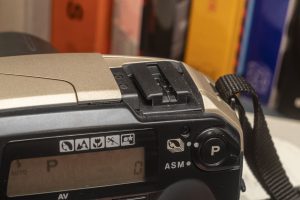
I really liked the location of the rear LCD as I found it to be faster to see the status of the camera compared to the top plate location favored by many electronic SLRs. While this same location would later become dominated by LCD on digital cameras of the next decade, for the remainder of the film era, I find it to be a missed opportunity that camera makers didn’t include more LCD screens on the rear of the camera.
Regarding the APS format, it is difficult for me to assess how useful many of it’s features were, as while Dwayne’s Photo had no problems developing the film, they no longer include the index card and I would have had to pay quite a bit extra for prints, so I chose to get the developed film back without prints and just scan them in myself. As I had no film holders of the correct size for my Epson scanner, I had to get creative, sandwiching the developed film in between two pieces of glass, laid directly onto the bed of my Epson scanner.
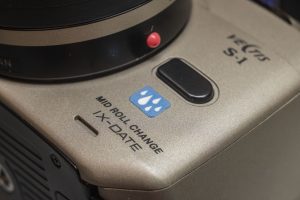
Looking at the images on my screen, the expired film showed more grain than likely would have been there when it was fresh, so it is also difficult to assess overall image quality. From what I could see though, I do feel as though for the era in which is was made, APS film and cameras like the Minolta Vectis S-1 would have been attractive options for many people.
In my life, I’ve had very little experience with the APS system, but feel the Vectis S-1 is a great first, and also last camera to experience it. Minolta did a great job of rethinking how an SLR should work, without alienating people coming from 35mm into a new system, while offering a level of simplicity that wouldn’t scare off those who had only ever used point and shoots.
Regardless of how good the Vectis S-1 is however, we have the benefit of hindsight to know that the format wasn’t successful, making any desire to keep shooting APS cameras a difficult pill to swallow.
Related Posts You Might Enjoy
External Links
http://camera-wiki.org/wiki/Minolta_Vectis_S-1
https://www.jaymclaughlin.co.uk/blog/2018/9/6/minolta-vectis-s-1-review-1996
http://www.submin.com/aps/collection/minolta/cameras/vectis_s1.htm

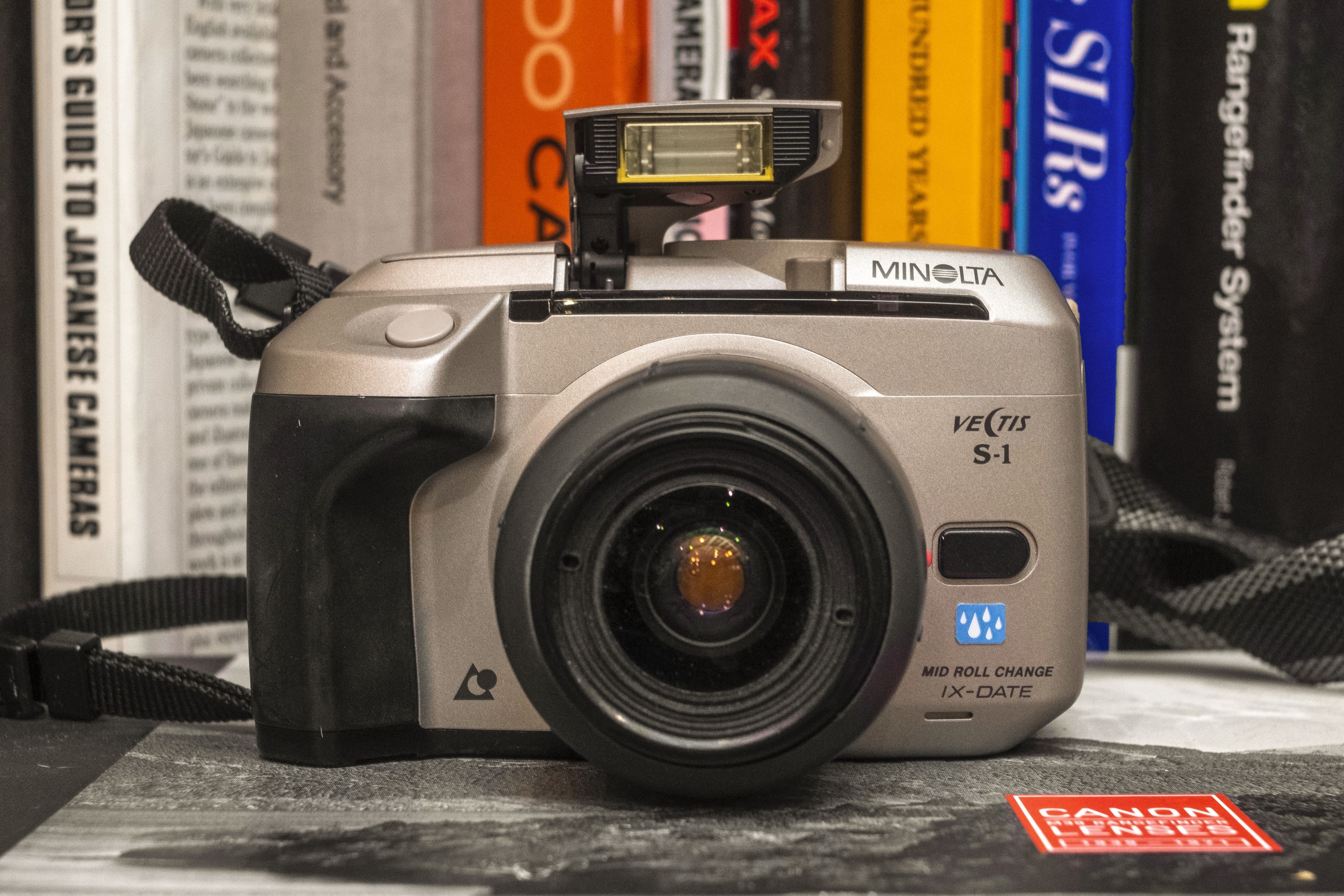
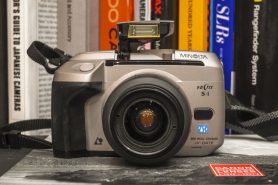
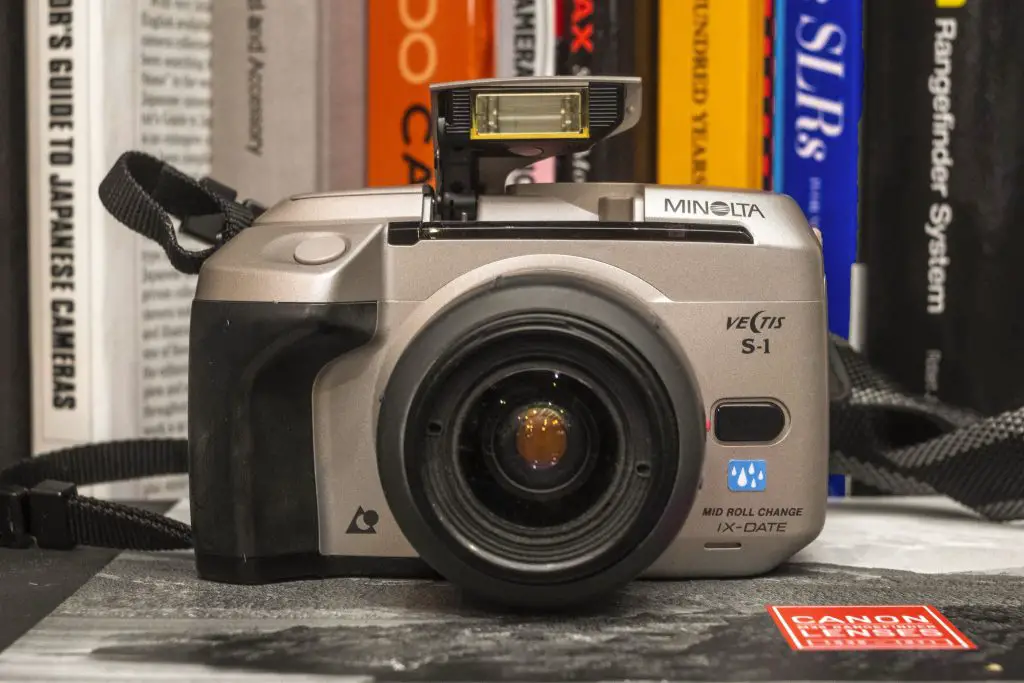


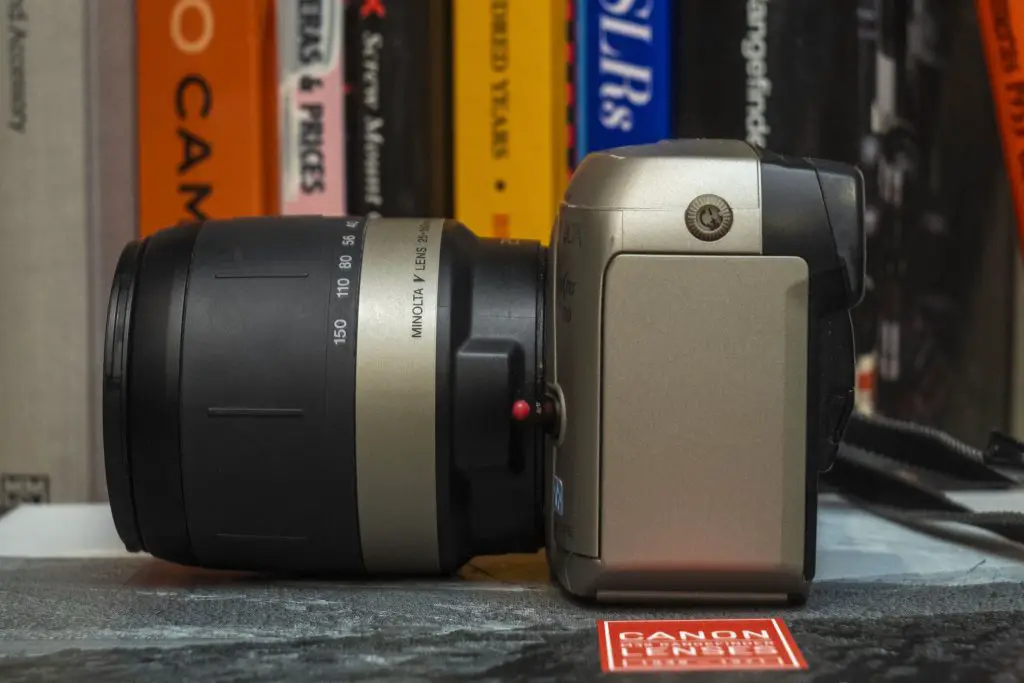

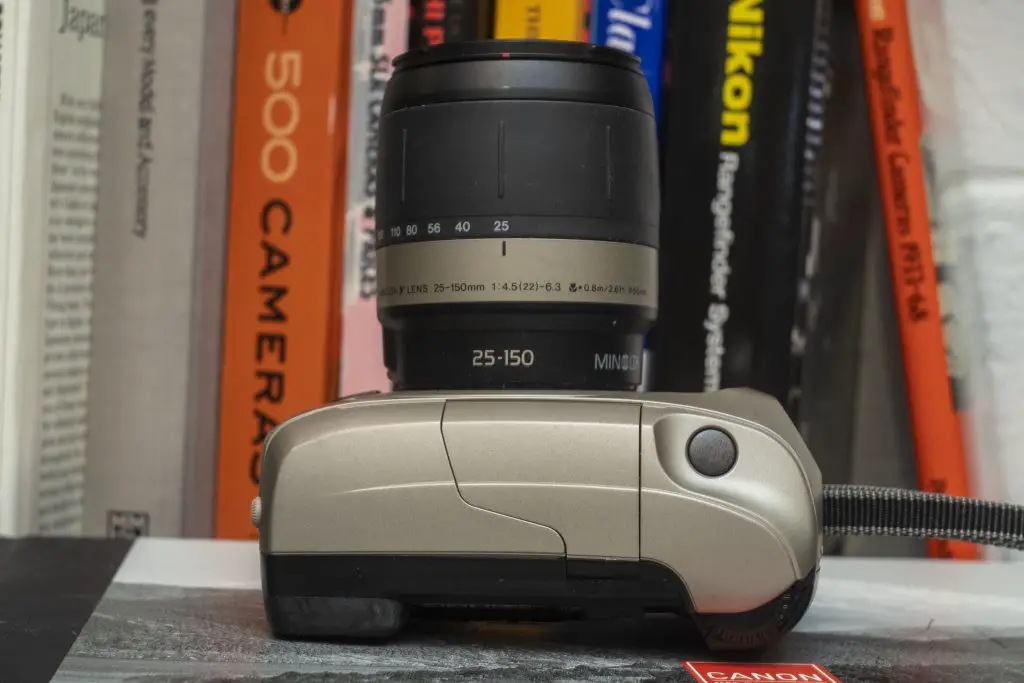
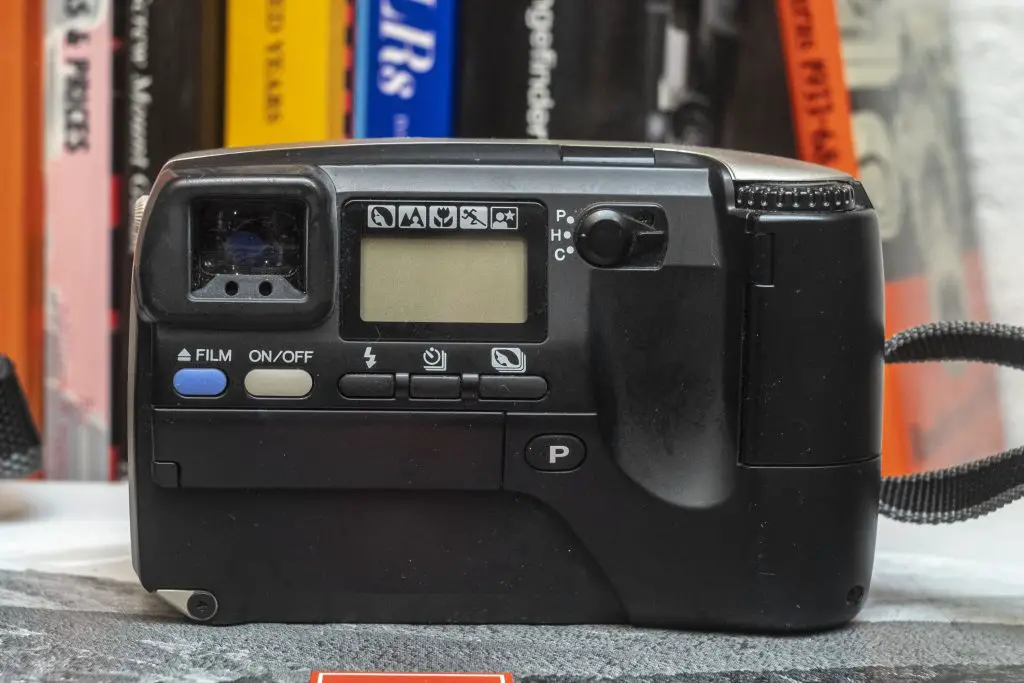
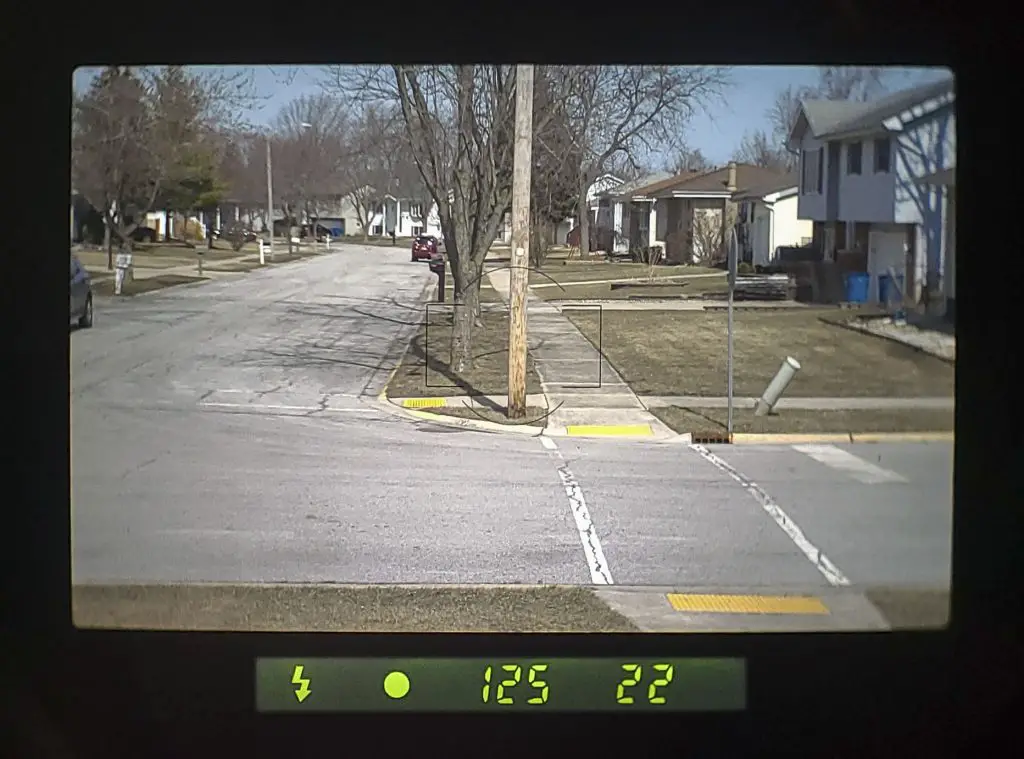
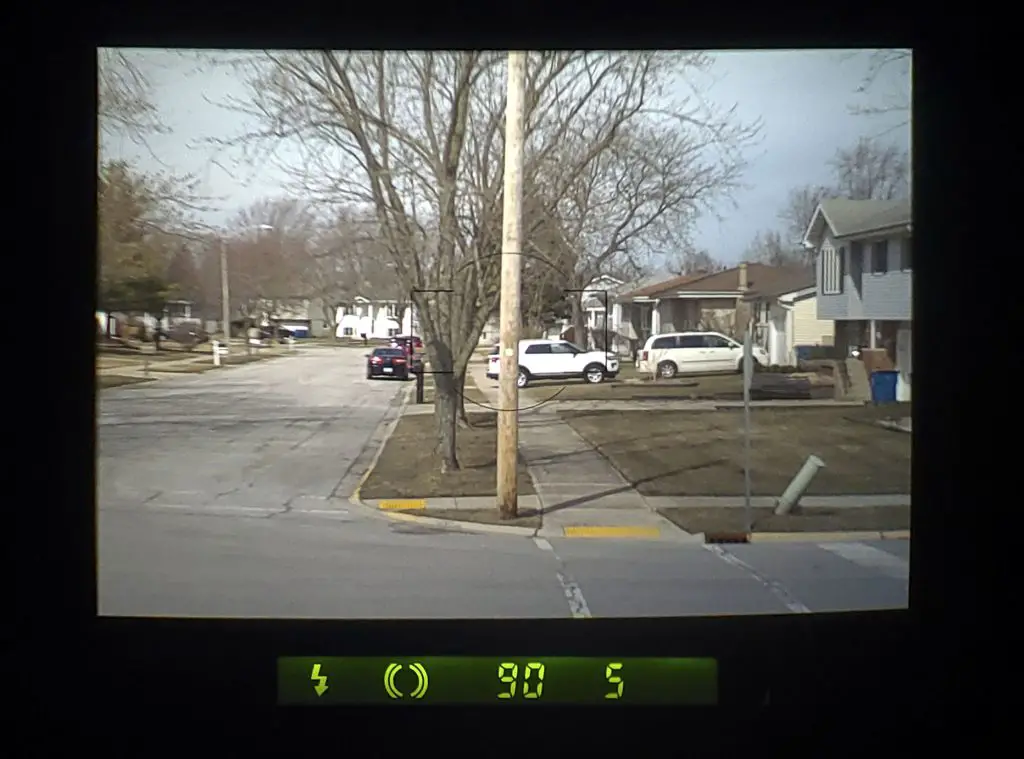
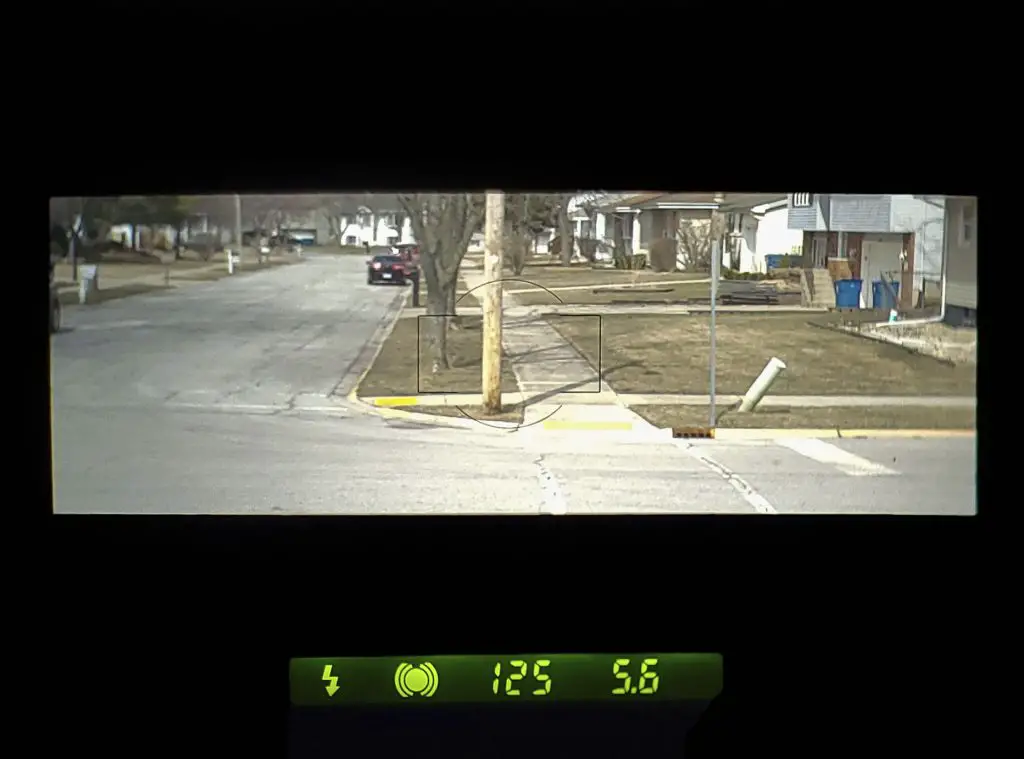












Hey, thanks for the depth you went into for this camera. I’ve acquired two S-1 cameras, a load of lenses (included the rare 17mm) and accessories, but have very little use apart from the sentimental value of them. I’ve searched but there’s no use for the lenses beyond this model of Minolta, is that still the case?
Hi Mike! I bought a Vectis S-1 in 1998 (I think) with 22-80mm f/4-5.6 and 56-170mm 4.5-5.6 zooms. I was hoping APS would combine the compact convenience of my Olympus Stylus Zoom and the SLR versatility of my Nikon FE2, with the latest in camera autofocus, autoexposure and light metering technology.
It was a total success for me, and the S-1 was my constant companion for about five years. It focused well, except in low light (like every other AF SLR of the ’90s). Exposures were spot on (I used real Kodak processing, not drug-store, because they actually used the IX data – though it took a week to get the photos back). Auto slow-shutter speed, fill-flash was convenient. Prints were sharp at 4 x 7 inch. I never got big blowups, but little grain was visible in 4 x 11 1/2 panoramic prints (12x enlargement) with ISO 200 film. The APS index print, with all the thumbnails, and print back data encoding were big steps forward from the 35mm film processing I was used to. I was surprised the lenses came with lens hoods – they were the first plastic hoods I ever had. When Pop Photo declared in February 2003 that APS was dying, I agonized for a year before buying a Nikon N80 (which turned out to be my last film camera).
By the way, Pop Photo said the list price for the S-1, body only, was $590 in 1996, $462 in 1997, $359 in 1998, and $291 in 1999-2000. Don’t forget, film camera selling prices were about 30-40% below list.
Excellent info Paul, thanks for the additional info about the prices on the S-1. I agree with everything you’ve said. Although this is my only APS review, I have shot a number of other models, even the Pronea 6s and none compare to the Vectis S-1. I so wish APS film was still made, these small cameras would be a lot of fun to shoot. The existing stocks age poorly, to where its not even worth it to shoot anymore.
Very nice review… let me add this from my own experience from the late 1990s to early 2000s.
“Just brought out my (rare in U.S.) black Vectis S-1 and attached the 400mm mirror lens. Just wanted to refresh my memory re the feel of that & my ability to hold it steady.
“For several years in early 2000s the S-1 was my preferred travel camera to Europe for the light weight/small size. I have several lenses: 17mm (metal/heavy, originally for a Minolta RD-3000 digital camera using that mount), the very good 50mm macro, two zooms, and the 400mm. The spot meter often was especially helpful.
“I also have a many frozen rolls of 100 ISO film and, for the 400mm, 6 rolls of the 800 ISO film that Fuji introduced late in the APS life span. Film has been frozen for years so it will be interesting to see how it has held up. Most of my film is 100 speed and that works well for enlargements up to 8×12. Never tried anything larger than that.
“Also have a variety of accessories made for this camera… including an odd looking protective cage. Never used that thing as it defeated the “small” advantage.
“All in all, Minolta invested more in this than Nikon and Canon, who also made APS SLR cameras. The Nikon & Canons used lenses that with the same mount as their 35mm SLRS. Minolta was the only one with a new mount. That helped with the small size but alas, that’s also why the lenses can’t be used with other cameras today.”